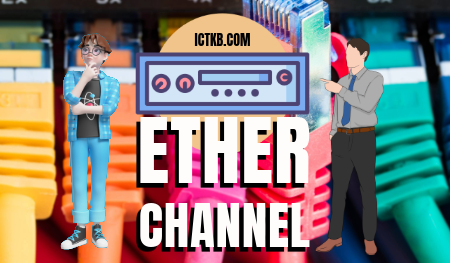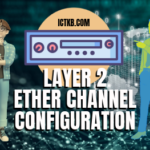Ether Channel is a port link aggregation technology developed by Cisco, which provides fault-tolerant high-speed links between Switches, Routers, and Servers. Ether Channel technology allows multiple physical Ethernet links (Fast Ethernet or Gigabit Ethernet) to combine into one logical channel. Ether Channel technology allows grouping of several physical Ethernet links (Fast Ethernet, Gigabit Ethernet, or 10 Gigabit Ethernet) to create one logical Ethernet link for the purpose of providing fault-tolerance and high-speed links between switches, routers and servers.
Ether Channel technology can be used to increase the bandwidth between two devices that support Ether Channel technology and Ether Channel technology provides automatic recovery for the loss of a link by redistributing the load across the remaining links. Ether Channel technology allows automatic redirection of network traffic from the failed link to the remaining links in Ether Channel. An Ether Channel consists of individual Fast Ethernet or Gigabit Ethernet or 10-Gigabit links bundled into a single logical link. The EtherChannel provides full-duplex bandwidth up to 800 Mbps (Fast EtherChannel FEC) or 8 Gbps (Gigabit EtherChannel) or 10 Gbps (10-Gigabit Etherchannel 10 GEC) between Switches, Routers and Servers.
The main advantages of Ether Channel technology are that it allows load sharing of traffic among the links in the channel as well as redundancy in the event that one or more links in the Ether Channel fail.
Criteria:
- Same duplex
- Same speed
- Same VLAN configuration (i.e., native VLAN and allowed VLAN should be same)
- Switch port modes should be the same (access or trunk mode)
EtherChannel protocols
To form an EtherChannel, there are 2 protocols, port aggregation Protocol (PAgP) and link aggregation control protocol (LACP).
1. Port Aggregation Protocol (PAgP)
The Cisco proprietary protocol Port Aggregation Protocol (PAgP) is an EtherChannel technology. It’s a type of data/traffic load balancing that involves the logical aggregation of Cisco Ethernet switch ports. A PAgP EtherChannel can merge up to eight physical links into one virtual link. LACP, or Link Aggregation Control Protocol, is an IEEE open standard. These are namely:
- ON: In this mode, the interface will be a part of EtherChannel but no negotiation takes place.
- Desirable: In this mode, the interface will continuously attempt to convert the other side interface into an EtherChannel.
- Auto: In this mode, the interface will become a part of EtherChannel if and only if it is requested by the opposite interface.
- Off: No EtherChannel configured on the interface.
2. Link Aggregation Control Protocol (LACP) –
Link Aggregation Control Protocol is an IEEE protocol, originally defined in 802.3ad, used to form an EtherChannel. This protocol is almost similar to Cisco PAgP. There are different modes in which you can configure your interface. These are namely:
- ON: In this mode, the interface will be a part of EtherChannel but no negotiation takes place
- Active: In this mode, the interface will continuously attempt to convert the other side interface into an EtherChannel.
- Passive: In this mode, the interface will become a part of EtherChannel if and only if it is requested by the opposite interface.
- Off: No EtherChannel configured on the interface.
EtherChannel has several advantages:
Increased bandwidth: Combining multiple connections with EtherChannel creates a wider “pipe” for data between switches, leading to faster network performance and fewer bottlenecks.
Improved redundancy: EtherChannel creates a single logical link from several physical ones, increasing redundancy. Traffic automatically switches to healthy links if one fails.
Load balancing: EtherChannel balances traffic across several physical links, optimizing bandwidth usage and avoiding congestion on individual connections.
Simplified network configuration: EtherChannel cuts through network complexity by treating multiple links as one. This makes setting things up and fixing problems much easier.
Cost-effective: EtherChannel is a budget-friendly way to get more out of your network. It leverages your existing cables for higher bandwidth and redundancy, eliminating the need for expensive upgrades.
Ether Channel Mis-Configuration guard
Port-channel or logical interface has a Mac address and while sending Data it uses single MAc address of Logical interface which can be any single physical interface MAC address. In cisco it is default enabled.
While configuring port-channel, if one switch is configured ether channel and another is not, switch 1 will send all control plain traffic with same Mac and it will think that it will receive all traffic with same MAC address but in switch 2 no ether channel is configured so switch 1 will receive with different MAC address. So, while happening this Switch1 will put it ’same all port into Error-disable mode. So, it is preferred to be configured EtherChannel after shutdown Neighbour’s interface.




